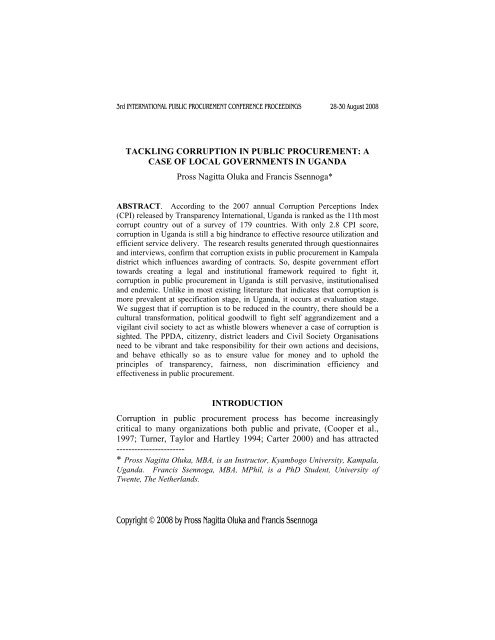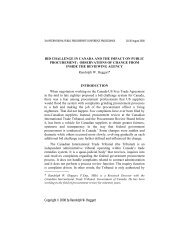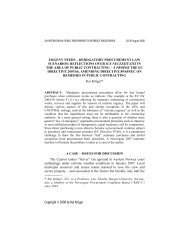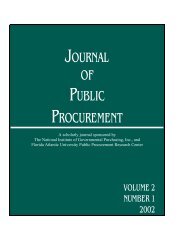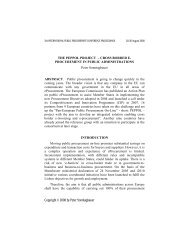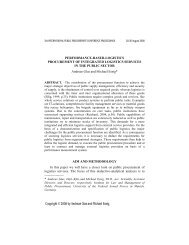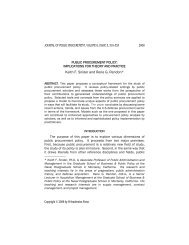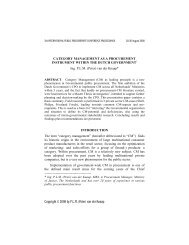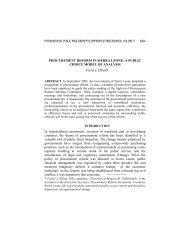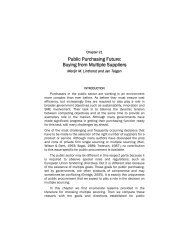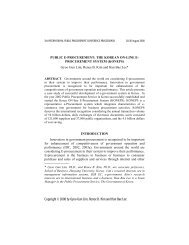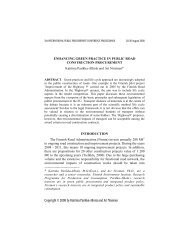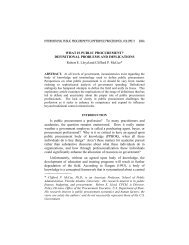Tackling Corruption in Public Procurement - ippa.org - International ...
Tackling Corruption in Public Procurement - ippa.org - International ...
Tackling Corruption in Public Procurement - ippa.org - International ...
You also want an ePaper? Increase the reach of your titles
YUMPU automatically turns print PDFs into web optimized ePapers that Google loves.
3rd INTERNATIONAL PUBLIC PROCUREMENT CONFERENCE PROCEEDINGS 28-30 August 2008<br />
TACKLING CORRUPTION IN PUBLIC PROCUREMENT: A<br />
CASE OF LOCAL GOVERNMENTS IN UGANDA<br />
Pross Nagitta Oluka and Francis Ssennoga*<br />
ABSTRACT. Accord<strong>in</strong>g to the 2007 annual <strong>Corruption</strong> Perceptions Index<br />
(CPI) released by Transparency <strong>International</strong>, Uganda is ranked as the 11th most<br />
corrupt country out of a survey of 179 countries. With only 2.8 CPI score,<br />
corruption <strong>in</strong> Uganda is still a big h<strong>in</strong>drance to effective resource utilization and<br />
efficient service delivery. The research results generated through questionnaires<br />
and <strong>in</strong>terviews, confirm that corruption exists <strong>in</strong> public procurement <strong>in</strong> Kampala<br />
district which <strong>in</strong>fluences award<strong>in</strong>g of contracts. So, despite government effort<br />
towards creat<strong>in</strong>g a legal and <strong>in</strong>stitutional framework required to fight it,<br />
corruption <strong>in</strong> public procurement <strong>in</strong> Uganda is still pervasive, <strong>in</strong>stitutionalised<br />
and endemic. Unlike <strong>in</strong> most exist<strong>in</strong>g literature that <strong>in</strong>dicates that corruption is<br />
more prevalent at specification stage, <strong>in</strong> Uganda, it occurs at evaluation stage.<br />
We suggest that if corruption is to be reduced <strong>in</strong> the country, there should be a<br />
cultural transformation, political goodwill to fight self aggrandizement and a<br />
vigilant civil society to act as whistle blowers whenever a case of corruption is<br />
sighted. The PPDA, citizenry, district leaders and Civil Society Organisations<br />
need to be vibrant and take responsibility for their own actions and decisions,<br />
and behave ethically so as to ensure value for money and to uphold the<br />
pr<strong>in</strong>ciples of transparency, fairness, non discrim<strong>in</strong>ation efficiency and<br />
effectiveness <strong>in</strong> public procurement.<br />
INTRODUCTION<br />
<strong>Corruption</strong> <strong>in</strong> public procurement process has become <strong>in</strong>creas<strong>in</strong>gly<br />
critical to many <strong>org</strong>anizations both public and private, (Cooper et al.,<br />
1997; Turner, Taylor and Hartley 1994; Carter 2000) and has attracted<br />
-----------------------<br />
* Pross Nagitta Oluka, MBA, is an Instructor, Kyambogo University, Kampala,<br />
Uganda. Francis Ssennoga, MBA, MPhil, is a PhD Student, University of<br />
Twente, The Netherlands.<br />
Copyright © 2008 by Pross Nagitta Oluka and Francis Ssennoga
OLUKA & SSENNOGA 1110<br />
significant attention from governments, civil society <strong>in</strong>stitutions and<br />
<strong>in</strong>ternational bodies. In Uganda, the government attaches a great deal of<br />
importance to tackl<strong>in</strong>g the problem of corruption, for it is aware that<br />
corruption underm<strong>in</strong>es good governance and retards economic<br />
development to which it is committed. It has hence set up several<br />
<strong>in</strong>stitutions such as; Inspector of Government (IGG), M<strong>in</strong>istry of Gender,<br />
Ethics and <strong>in</strong>tegrity, <strong>Public</strong> Accounts Committee (PAC), Auditor<br />
General (AG) among others, aimed at stamp<strong>in</strong>g out corruption from<br />
government departments.<br />
A National Integrity Survey carried out <strong>in</strong> 2002 by the Inspector<br />
General of Government found that Local Government Tender Boards<br />
were perceived to be the second most corrupt <strong>in</strong>stitution <strong>in</strong> Uganda,<br />
exceeded only by the Police. Through the policy of decentralization<br />
significant powers, functions, responsibilities and resources were<br />
devolved from the central government to local governments.<br />
Decentralization <strong>in</strong> Uganda is firmly based on the presumption that<br />
improved local governance can be achieved through devolution of<br />
political powers and functions, along with fiscal resources, and that this<br />
will improve service delivery and <strong>in</strong> turn positively impact on poverty.<br />
Local governments are now responsible for the bulk of adm<strong>in</strong>istrative<br />
and political processes with<strong>in</strong> their respective areas of jurisdiction. Local<br />
governments are charged to address social, economic, political,<br />
<strong>in</strong>frastructural backlogs and <strong>in</strong>equalities <strong>in</strong> a manner to ensure that<br />
developmental outcomes are reached.<br />
With the magnitude of roles and responsibilities devolved to the<br />
local governments, an equal amount of f<strong>in</strong>ancial resources has been<br />
decentralized (devolved). Total transfers from the Central to local<br />
governments have <strong>in</strong>creased from Ug. Shs. 225.23 billions 1997/98<br />
f<strong>in</strong>ancial year to Ug. Shs.1, 099.67 billion 2007/08 f<strong>in</strong>ancial year<br />
(Background to the budget 2007). With this <strong>in</strong>creased f<strong>in</strong>ancial<br />
autonomy <strong>in</strong> Local governments, the procurement function is<br />
<strong>in</strong>creas<strong>in</strong>gly becom<strong>in</strong>g very important. This is because we are <strong>in</strong> a”<br />
global procurement reform fever” that demands an efficient and effective<br />
system of acquir<strong>in</strong>g goods, services and works. Local governments now<br />
handle huge sums of money to procure contracts like feeder road<br />
construction, water supply, construction of health units and primary<br />
schools, supplies to district hospitals and lower health units, school<br />
furniture and many others. It is with this background that there is need
TACKLING CORRUPTION IN PUBLIC PROCUREMENT 1111<br />
for <strong>in</strong>creased accountability at local governments. However as <strong>in</strong>dicated,<br />
corruption at local government is still prevalent.<br />
So despite the effort to curb out corruption by government and its<br />
development partners, it has persisted <strong>in</strong> public procurement. The<br />
procurement process still has a lot of problems <strong>in</strong>clud<strong>in</strong>g <strong>in</strong>fluence<br />
peddl<strong>in</strong>g, <strong>in</strong>trigue, and lack of transparency <strong>in</strong> select<strong>in</strong>g the “lead<br />
agencies” to be funded. This has led to non-optimization of resources e.g.<br />
shoddy work, collaps<strong>in</strong>g pit latr<strong>in</strong>es and school blocks, uncompleted<br />
hospital theatres, defective equipment, shortage of medic<strong>in</strong>es, textbooks,<br />
school desks which are be<strong>in</strong>g funded from Poverty Action Fund<br />
resources, (New Vision, Sunday, 14th January, 2007; Coronel and Tirol,<br />
2002). <strong>Public</strong> and private <strong>in</strong>dividuals have abused the public trust to<br />
enrich themselves. The actions of these <strong>in</strong>dividuals have created the<br />
appearance that contracts are not awarded <strong>in</strong> a fair and open process, and<br />
that contractors must “pay to play”. This has serious implications which<br />
may possibly derail the development process. The war on corruption <strong>in</strong><br />
public procurement must be worn.<br />
In this paper we seek to explore the reasons for cont<strong>in</strong>ued corruption<br />
<strong>in</strong> local government procurement process, the most vulnerable stage to<br />
corrupt practices plus the strategies that need to be undertaken <strong>in</strong> order to<br />
elim<strong>in</strong>ate it. By identify<strong>in</strong>g the most vulnerable stage to corruption,<br />
policy makers can respond to risks of corruption <strong>in</strong> general by ensur<strong>in</strong>g a<br />
good public procurement system and <strong>in</strong>stitut<strong>in</strong>g control systems to<br />
enhance the accountability and transparency with<strong>in</strong> the procurement<br />
system and hence be able to detect and prevent corruption. Specifically,<br />
the follow<strong>in</strong>g research questions are discussed:<br />
• What are the reasons for the cont<strong>in</strong>ued corruption <strong>in</strong> Uganda’s local<br />
government<br />
• What is the most vulnerable stage to corruption <strong>in</strong> the procurement<br />
process<br />
• What strategies can be developed to curb corruption <strong>in</strong> local<br />
government procurement <strong>in</strong> Uganda<br />
The rest of the paper is <strong>org</strong>anized <strong>in</strong> the follow<strong>in</strong>g manner. Part II<br />
briefly <strong>in</strong>troduces the literature that expla<strong>in</strong>s how corruption is perceived<br />
<strong>in</strong> Uganda, causes of cont<strong>in</strong>ued corruption <strong>in</strong> the public sector and an<br />
overview of vulnerable moments of procurement process. Part III deals<br />
with the methodology. Part IV presents the f<strong>in</strong>d<strong>in</strong>gs and discussions. Part
OLUKA & SSENNOGA 1112<br />
V presents conclud<strong>in</strong>g commentary and policy recommendations for<br />
address<strong>in</strong>g the problem.<br />
LITERATURE REVIEW<br />
ganda corruption perception Index Rank<strong>in</strong>g<br />
<strong>Corruption</strong> is def<strong>in</strong>ed variously by several authors as “the misuse of<br />
entrusted power for private ga<strong>in</strong>” (T I, 2002, Shah 2006, Andvig 2006,<br />
Kaufman and Vicente 2005; Mishra, 2006). Wei, (1999) contends that<br />
“corruption is an unethical and illegal practice that bleeds the public<br />
purse, erodes public and bus<strong>in</strong>ess confidence <strong>in</strong> government as provider<br />
and customer respectively and <strong>in</strong>creases <strong>in</strong>debtedness”. <strong>Corruption</strong><br />
specific to public procurement especially harms the poor because it<br />
distorts the allocation of scarce resources (Ackermann, 1998)<br />
The government of Uganda <strong>in</strong> its National Strategy to fight<br />
corruption and rebuild ethics and <strong>in</strong>tegrity <strong>in</strong> <strong>Public</strong> Office (2004–2007)<br />
launched <strong>in</strong> July 2004, recognizes that corruption <strong>in</strong> public procurement<br />
and service delivery poses a serious obstacle to economic and social<br />
development <strong>in</strong> Uganda. The need to fight corruption is further<br />
strengthened by the Transparency <strong>International</strong> rank<strong>in</strong>g that pa<strong>in</strong>ts a<br />
gloomy picture about Uganda. The rank<strong>in</strong>g Transparency <strong>International</strong><br />
(TI) over an eight year period through the, <strong>Corruption</strong> Perceptions Index<br />
(CPI) <strong>in</strong>dicate that Uganda needs to further strengthen its effort to fight<br />
corruption. At a score of only 2.8 aga<strong>in</strong>st a clean scale of 10, Uganda is<br />
ranked among those countries that are really <strong>in</strong> a critical situation.<br />
United States Agency for <strong>International</strong> Development (USAID),<br />
Development Assistance Grant Agreement (2007) on fight<strong>in</strong>g corruption<br />
po<strong>in</strong>ts out that despite the government’s effort to fight corruption, it still<br />
cont<strong>in</strong>ues to constra<strong>in</strong> severely public policy execution and public<br />
service delivery. USAID further po<strong>in</strong>ts out that although serious<br />
challenges exist at a variety of levels and <strong>in</strong> a variety of sectors<br />
corruption with<strong>in</strong> the public procurement process represents a<br />
particularly acute concern and a major threat to the economy of Uganda.<br />
Development partners particularly note the poor quality road works<br />
which they perceive to be as a result of high levels of corruption <strong>in</strong> the<br />
contractual process (Wasike, The New Vision, 14 January, 2007).
TACKLING CORRUPTION IN PUBLIC PROCUREMENT 1113<br />
Year of CPI<br />
Survey<br />
TABLE 1<br />
Uganda CPI Score for a Period of Seven Years<br />
CPI score for Uganda<br />
(10 highly clean and 0<br />
highly corrupt)<br />
Uganda’s<br />
Rank<br />
2000 2.3 80 90<br />
2001 1.9 102 145<br />
2002 2.1 93 102<br />
2003 2.2 113 133<br />
2004 2.6 102 145<br />
2005 2.5 117 159<br />
2006 2.7 105 163<br />
2007 2.8 111 179<br />
Source: Derived from TI CPI Reports www.transparency.<strong>org</strong><br />
Countries<br />
Appear<strong>in</strong>g<br />
<strong>in</strong> the Survey<br />
<strong>Corruption</strong> <strong>in</strong> Uganda does not only <strong>in</strong>clude m<strong>in</strong>or cases but high<br />
profile cases as well, characterized by <strong>in</strong>fluence peddl<strong>in</strong>g <strong>in</strong> the<br />
procurement process and direct embezzlement. The Global Alliance for<br />
Vacc<strong>in</strong>es and immunization (GAVI) fund Report by IGG (2006)<br />
implicated three high profile m<strong>in</strong>isters <strong>in</strong> the irregular contract awards<br />
and disappearance of billions of shill<strong>in</strong>gs meant for HIV/AIDS (Human<br />
Immune Virus/Acquired Immune Deficiency Syndrome), and malaria<br />
prevention and treatment.<br />
Cont<strong>in</strong>ued Persistence of <strong>Corruption</strong> <strong>in</strong> <strong>Public</strong> Sector<br />
<strong>Corruption</strong> <strong>in</strong> Uganda has persisted because it is bred and nourished<br />
by moral decadence, loss of ethics and <strong>in</strong>tegrity, shamelessness, societal<br />
adoration of wealth and materialism, greed and poverty (Epak 2005). In<br />
fact the causes of corruption might help to expla<strong>in</strong> its cont<strong>in</strong>ued<br />
persistence <strong>in</strong> the public sector. The Ugandan traditional system of<br />
rulers, leaders, or chiefta<strong>in</strong>cy encouraged or for that matter survived on<br />
the bestow<strong>in</strong>g of gifts, patronage and favours. Even women were given<br />
as gifts to chiefs for wives. This type of corruption deeply rooted <strong>in</strong><br />
cultural practices of hav<strong>in</strong>g to give someth<strong>in</strong>g for someth<strong>in</strong>g cannot be<br />
wished away <strong>in</strong> one day. However s<strong>in</strong>ce the practices were not perceived<br />
to be bad or corrupt they were carried out openly. This attitude lives with<br />
us up to today, except that today they are done rather privately.
OLUKA & SSENNOGA 1114<br />
Cultural engra<strong>in</strong>ed practices set aside; corruption has roots <strong>in</strong> the<br />
breakdown of rule of law that dom<strong>in</strong>ated after-<strong>in</strong>dependence Uganda.<br />
More especially the systems of control, transparency, accountability and<br />
management broke down dur<strong>in</strong>g Am<strong>in</strong>'s period of dictatorship and<br />
chaotic rule. Instability and <strong>in</strong>security of job tenure result<strong>in</strong>g from the<br />
political upheavals of the time made employees feel <strong>in</strong>secure <strong>in</strong> their job<br />
and hence grabbed whatever they could lay their hands on. <strong>Corruption</strong><br />
was also exacerbated by the population expand<strong>in</strong>g while the economy<br />
contracted the standard of liv<strong>in</strong>g deteriorated and the cost of liv<strong>in</strong>g<br />
<strong>in</strong>creased. <strong>Corruption</strong> permeated every sphere of public life and the<br />
population became resigned to it as <strong>in</strong>evitable.<br />
<strong>Corruption</strong> is most prevalent where there are other forms of<br />
<strong>in</strong>stitutional <strong>in</strong>efficiency, such as political <strong>in</strong>stability, bureaucratic red<br />
tape, and weak legislative and judicial systems. Ellis (2005) notes that<br />
whereas there has been <strong>in</strong>creased effort to reform and de-politicize and<br />
professionalize the local government procurement system <strong>in</strong> Uganda<br />
with effort to reduce corruption, laws and regulations alone were not<br />
enough to combat the vice. However, underly<strong>in</strong>g all these issues are<br />
<strong>in</strong>stitutional weaknesses that need to be addressed. The capacity and<br />
<strong>in</strong>tegrity of enforcement need to be enhanced. The best law has no value<br />
if it is not enforced. The best judges and magistrates are wasted if cases<br />
are never brought to them. Good <strong>in</strong>vestigations are wasted effort if the<br />
judge or magistrate is corrupt (Petter Langseth 1999). Loose or opaque<br />
rules that are also poorly enforced, patronage arrangements, ma<strong>in</strong>tenance<br />
of the status quo, protection of vested <strong>in</strong>terests at all cost, formation of<br />
local bus<strong>in</strong>ess cartels that lock out competition especially from<br />
<strong>in</strong>ternational firms, and procurement used as a basis for reward<strong>in</strong>g<br />
political supporters, and to f<strong>in</strong>ance political parties are critical issues that<br />
have perpetuated corruption <strong>in</strong> develop<strong>in</strong>g countries (Hunja 2003)<br />
Most Vulnerable Stage of the <strong>Public</strong> <strong>Procurement</strong> Process<br />
The procurement process can be divided <strong>in</strong> the five follow<strong>in</strong>g<br />
phases: (i) procurement plann<strong>in</strong>g and needs assessment, (ii) product<br />
design and document preparation, (iii) tender process (<strong>in</strong>clud<strong>in</strong>g<br />
advertis<strong>in</strong>g, <strong>in</strong>vitation to bid, prequalification, bid evaluation, post<br />
qualification), (iv) contract award and implementation, and (v) f<strong>in</strong>al<br />
account<strong>in</strong>g and audit. The risk of corruption exists at every stage of the<br />
process (OECD 2007) Accord<strong>in</strong>g to the same OECD report the major<br />
risk of corruption comes from a lack of transparency, limited access to
TACKLING CORRUPTION IN PUBLIC PROCUREMENT 1115<br />
<strong>in</strong>formation and lack of accountability and control at each stage of the<br />
procurement process. Collusion is frequent dur<strong>in</strong>g the phases of<br />
procurement plann<strong>in</strong>g and document preparation, where <strong>in</strong>vestigations<br />
are most difficult. Conversely, corruption is most easily detected and<br />
<strong>in</strong>vestigated dur<strong>in</strong>g the phase of contract implementation. An area with<br />
particular high risk for corruption is sub-contract<strong>in</strong>g dur<strong>in</strong>g contract<br />
execution. Other vulnerable areas to corruption are the phases of needs<br />
assessment, project specifications and bid evaluation. It attempts to<br />
highlight at each of these stages the risk areas as identified <strong>in</strong> Diagram 1.<br />
As seen <strong>in</strong> the diagram above and <strong>in</strong> l<strong>in</strong>e with the National Integrity<br />
Basel<strong>in</strong>e Survey, 2006; Pidaparthi 2003 revealed that all stages of the<br />
process are prone to corrupt practices. Similarly, TI (2006) found that<br />
corruption at the stages at which it occurs could be due to; Limited or<br />
restricted access to <strong>in</strong>formation; abuse of exceptions to open public<br />
bidd<strong>in</strong>g; Limited or <strong>in</strong>effective control and monitor<strong>in</strong>g with<strong>in</strong> the<br />
contract<strong>in</strong>g process and particularly dur<strong>in</strong>g the contract implementation<br />
phase; and deficiencies and lack of transparency dur<strong>in</strong>g the budget phase<br />
and further asserts that public procurement procedures are often complex<br />
DIAGRAM 1<br />
Areas Vulnerable to <strong>Corruption</strong> <strong>in</strong> the <strong>Procurement</strong> Stages<br />
Source: OECD (2007).
OLUKA & SSENNOGA 1116<br />
and transparency of the processes is limited, and manipulation is hard to<br />
detect. This argument is supported by Matechak(2005) who observes<br />
that corruption opportunities are abound at all stages of the procurement<br />
process. Asian Development Bank, Organisation for Economic Cooperation<br />
and Development(ADB/ OECD, 2006), observes that<br />
procurement plann<strong>in</strong>g <strong>in</strong> particular, needs assessment and def<strong>in</strong>ition of<br />
technical specifications and the delivery phase are particularly exposed<br />
to corruption.<br />
Strategies to Curb <strong>Corruption</strong> <strong>in</strong> <strong>Public</strong> <strong>Procurement</strong><br />
The legal and <strong>in</strong>stitutional framework sett<strong>in</strong>g out the basic conditions<br />
and the manner <strong>in</strong> which procurement may be undertaken procedurally,<br />
the results that can be expected, and the potential efficiency ga<strong>in</strong>s that<br />
can be achieved(Hunja 2003) is crucial <strong>in</strong> the fight aga<strong>in</strong>st corruption.<br />
With<strong>in</strong> this environment, the commitment of public sector staff <strong>in</strong><br />
manag<strong>in</strong>g and adher<strong>in</strong>g to the requirements of the procurement process<br />
and tak<strong>in</strong>g advantage of the competition <strong>in</strong> the market is decisive to the<br />
outcome <strong>in</strong> terms of achiev<strong>in</strong>g the objectives of a national public<br />
procurement system<br />
Not disput<strong>in</strong>g the argument above, the World Bank (2004) confers<br />
that an effective anti-corruption strategy builds on five key elements:<br />
<strong>in</strong>creas<strong>in</strong>g political accountability, strengthen<strong>in</strong>g civil society<br />
participation, creat<strong>in</strong>g a competitive private sector, <strong>in</strong>stitutional restra<strong>in</strong>ts<br />
on power and improv<strong>in</strong>g public sector management. Others <strong>in</strong>clude; top<br />
political commitment, sound procurement legal framework<br />
(Transparency <strong>International</strong>- Uganda Chapter, 2007); Professionaliz<strong>in</strong>g<br />
procurement workforce and capacity build<strong>in</strong>g (Ferrell and Gresham<br />
1985; Laczniak, et al, 1995, Wood, 1995); workers themselves should<br />
care about ethics if they wish to work <strong>in</strong> respectful and ethical<br />
<strong>org</strong>anizations (Trev<strong>in</strong>o & Nelson, 1999); Khai, (2006) suggests strong<br />
procurement records management as a ways for detect<strong>in</strong>g corruption<br />
through <strong>in</strong>spection, sanction and report<strong>in</strong>g. Burt et al (2003) contends<br />
that supply managers have to be aware of the potential conflict of <strong>in</strong>terest<br />
when select<strong>in</strong>g suppliers which occurs when procurement managers<br />
divide their loyalty between the firm that employ them and another.<br />
Avoidance of show<strong>in</strong>g favoritism toward certa<strong>in</strong> suppliers, (Ferrell and<br />
Gresham 1985; Forker and Janson 1990; Doney and Cannon 1997),<br />
Stevens, et al, (2005) advocates for the use of ethics codes and
TACKLING CORRUPTION IN PUBLIC PROCUREMENT 1117<br />
participation of stakeholders: Harness<strong>in</strong>g the potential of new<br />
technologies.<br />
OECD (2007) urges governments to put <strong>in</strong> place accountability and<br />
control mechanisms <strong>in</strong> the public procurement office and <strong>in</strong> procur<strong>in</strong>g<br />
agencies such as <strong>in</strong>ternal audit; <strong>in</strong>ternal control mechanisms; External<br />
audit. Other external controls <strong>in</strong>clude public oversight bodies;<br />
parliamentary controls. However worth not<strong>in</strong>g is the fact the <strong>in</strong>stitutional<br />
mechanisms set <strong>in</strong> place should be backed up by commitment by all<br />
stakeholders to make it work.<br />
METHODOLOGY<br />
The research took the form of a s<strong>in</strong>gle case study (Eisenhardt 1989;<br />
Y<strong>in</strong> 1994) of Kampala District. Case study was particularly appropriate<br />
to the present <strong>in</strong>vestigation because it is about a contemporary<br />
phenomenon (Y<strong>in</strong>, 1984). <strong>Corruption</strong> <strong>in</strong> Uganda is a contemporary<br />
phenomenon eat<strong>in</strong>g up the social fiber and burden<strong>in</strong>g the economy. To<br />
obta<strong>in</strong> <strong>in</strong>-depth analysis, a case study design was chosen as contended by<br />
Stake (1995); “We study a case when it is of very special <strong>in</strong>terest. We<br />
look for the detail of <strong>in</strong>teraction with its contexts”. Case studies have<br />
been used to develop critical th<strong>in</strong>k<strong>in</strong>g (Alvarez, et al., 1990). Case<br />
studies tend to be selective, focus<strong>in</strong>g on one or two issues that are<br />
fundamental to understand<strong>in</strong>g the system be<strong>in</strong>g exam<strong>in</strong>ed. A qualitative<br />
descriptive research design was used to seek attitudes and op<strong>in</strong>ions on<br />
corruption <strong>in</strong> the procurement process from the technocrats who <strong>in</strong>cluded<br />
heads of departments and officials of the anti-corruption <strong>org</strong>anisations <strong>in</strong><br />
Uganda.<br />
Target Population and Selection of Target Sample<br />
The study focused on Kampala district. The study population<br />
comprised of District <strong>Procurement</strong> Officials, heads of district<br />
departments, and suppliers to Kampala district. This target group<br />
constituted people with experience and knowledge of the procurement.<br />
That is, people <strong>in</strong>volved <strong>in</strong> the day to day procurement activities with<strong>in</strong><br />
the districts- officials and suppliers. We also <strong>in</strong>terviewed the Civil<br />
Society Organisations (CSO) (T I-Uganda Chapter and Anti-<strong>Corruption</strong><br />
Coalition Organisation) who have the expertise on particular forms of<br />
corruption to get an overview of procurement practices <strong>in</strong> Uganda <strong>in</strong>
OLUKA & SSENNOGA 1118<br />
general and local governments <strong>in</strong> particular. This <strong>in</strong>formation was<br />
important <strong>in</strong> the collaboration of our f<strong>in</strong>d<strong>in</strong>gs.<br />
The target population was purposively selected with a total of 119<br />
members composed of technocrats (19 district staff) selected accord<strong>in</strong>g<br />
to their <strong>in</strong>volvement <strong>in</strong> procurement process and 100 pre-qualified<br />
providers. Technocrats <strong>in</strong>cluded 4 staff from the procurement unit, 5<br />
Contracts Committee members, 5 Executive members (cab<strong>in</strong>et of the<br />
district) who ensure transparency and are politically accountable and 5<br />
members of the evaluation committees.<br />
Stratified sampl<strong>in</strong>g was used given the heterogeneity of the<br />
respondents. The sample target was selected us<strong>in</strong>g simple random<br />
sampl<strong>in</strong>g 4 heads of department, 3 members from the district<br />
<strong>Procurement</strong> Unit, 3 executive members, 5 participants of the evaluation<br />
committee and 3 members from the Contracts Committee and 20<br />
providers). This gave a total sample of 38 respondents who were issued<br />
questionnaires. Four district staff and two officers from anti corruption<br />
agencies were <strong>in</strong>terviewed. To avoid problems related to the subjectivity<br />
of data, multiple sources of evidence were used (triangulation purposes)<br />
Data Analysis<br />
Data was presented and analyzed us<strong>in</strong>g descriptive statistics (mean<br />
and standard deviation). These statistics helped <strong>in</strong> understand<strong>in</strong>g the<br />
general behavior of data. The researchers’ aims were to f<strong>in</strong>d out the<br />
mean ranks with<strong>in</strong> each of the groups. The data collected was<br />
considered valid and reliable as all the respondents were purposively<br />
selected. On top of <strong>in</strong>terviews conducted a questionnaire with likert<br />
scales rang<strong>in</strong>g from 1-5(1-highest rat<strong>in</strong>g, highest and 5-least rat<strong>in</strong>g) was<br />
used. The number of <strong>in</strong>tended <strong>in</strong>terviewees at district was four and two<br />
from anti corruption <strong>org</strong>anisations. All the six were <strong>in</strong>terviewed and due<br />
to the sensitivity of the topic their identities are not revealed. The lowest<br />
mean score on a set of questions measur<strong>in</strong>g a particular parameter<br />
implied high prevalence of the parameter be<strong>in</strong>g tested. Conversely, a<br />
high mean score on question implied less significance of that aspect as a<br />
contributory factor on that parameter.
TACKLING CORRUPTION IN PUBLIC PROCUREMENT 1119<br />
FINDINGS AND DISCUSSIONS<br />
What are the reasons for the cont<strong>in</strong>ued corruption <strong>in</strong> Uganda’s local<br />
government<br />
Descriptive analysis <strong>in</strong>dicates that both groups of the respondents’ i.e<br />
technocrats and providers identified political <strong>in</strong>fluence as the lead reason<br />
for the cont<strong>in</strong>ued corruption <strong>in</strong> Kampala district. In table 2 below, the<br />
technocrats scored the least mean of 2.64 and the providers the least<br />
mean of 3.00 and s<strong>in</strong>ce the least score means the highest rank this would<br />
imply that political <strong>in</strong>fluence is the lead cause of corruption <strong>in</strong> Kampala<br />
District. The variability <strong>in</strong> the form of Standard deviation <strong>in</strong> both groups<br />
is also relatively low closely followed by low salaries.<br />
TABLE 2<br />
Descriptive Statistic<br />
Technocrats<br />
Std.<br />
Providers<br />
Std.<br />
Dev<br />
Causes N Mean Dev N Mean<br />
Cultural reasons 14 4.14 2.60 17 4.88 1.62<br />
Poor economic policies 14 5.36 1.50 17 4.76 1.71<br />
Low salaries of public<br />
officials 14 3.14 2.11 17 3.00 2.00<br />
Weak transparent procedures 14 4.14 1.41 17 3.94 1.64<br />
Greed for money 14 3.57 1.87 17 3.29 2.20<br />
Political <strong>in</strong>fluences 14 2.64 1.82 17 3.00 1.84<br />
Weak Institutional framework 14 4.64 1.69 17 5.12 1.96<br />
On clarification dur<strong>in</strong>g <strong>in</strong>terview it was confirmed that political<br />
<strong>in</strong>terference is due to <strong>in</strong>secure and precarious tenure of office. The<br />
district respondent further stated that when public officials feel <strong>in</strong>secure,<br />
and threatened by the possibility that they may not be voted <strong>in</strong>to office <strong>in</strong><br />
the next election, they try to grab as much as they can with<strong>in</strong> the shortest<br />
possible time. This was supported by an official from the anti-<strong>Corruption</strong><br />
Coalition who asserted that; “the tender<strong>in</strong>g process has been turned <strong>in</strong>to a<br />
bus<strong>in</strong>ess by politicians at the district to settle their economic problems<br />
and those of their key supporters, k<strong>in</strong> and bus<strong>in</strong>ess associates. He<br />
expla<strong>in</strong>ed further that political <strong>in</strong>fluence is due to monetization of the<br />
elections. He claimed that politicians spend a lot of money and others get
OLUKA & SSENNOGA 1120<br />
loans which they have to repay by way of award<strong>in</strong>g themselves contracts<br />
to recoup the expenses” hence the cont<strong>in</strong>ued corruption.<br />
The legal framework of decentralization was also blamed for not<br />
provid<strong>in</strong>g for prevention of corruption among politicians and yet it holds<br />
civil servants accountable for any form of graft. He argued that the law<br />
does not penalize politicians who unknow<strong>in</strong>gly or deliberately flout the<br />
law. He gave an example of the case of junk helicopters and ghost<br />
soldiers which implicated very high politicians and to date noth<strong>in</strong>g has<br />
been done to date. This analysis is also supported by documentary<br />
evidence <strong>in</strong> which some actions of the political leadership of the district<br />
were analysed. The Chairman LC 3 Kampala Central <strong>in</strong> the on-go<strong>in</strong>g<br />
<strong>in</strong>vestigation <strong>in</strong> Kampala district admitted to illegally award<strong>in</strong>g tenders.<br />
He said, “Dur<strong>in</strong>g the first six months of my tenure <strong>in</strong> office, whoever<br />
came to me for a tender, I just wrote a chit award<strong>in</strong>g them tenders<br />
without know<strong>in</strong>g that I was do<strong>in</strong>g it illegally” (Tebajjukira and Nakaayi,<br />
The New Vision, Tuesday, August 7, 2007).<br />
One member of the district executive further asserts that “the fight to<br />
eradicate corruption <strong>in</strong> Uganda public procurement has had a number of<br />
challenges due to the fact that a number of weaknesses <strong>in</strong> the present<br />
laws exists hence the reason why corruption persists. She gave examples<br />
of an <strong>in</strong>adequacy <strong>in</strong> the laws <strong>in</strong>volv<strong>in</strong>g weaknesses <strong>in</strong> the Penal Code<br />
Act; the Prevention of <strong>Corruption</strong> Act and; the Leadership Code of<br />
Conduct. A provision for the confiscation of ill-gotten wealth <strong>in</strong> all the<br />
three statutes seems to be lack<strong>in</strong>g.<br />
However one respondent argued that “<strong>in</strong> Uganda there is a cultural<br />
<strong>in</strong>cl<strong>in</strong>ation <strong>in</strong> Society. A culture of corruption has existed <strong>in</strong> the society<br />
right from pre-colonial times and this is not easy to get rid of. <strong>Public</strong><br />
officers who rendered services were always rewarded with goods and<br />
services and <strong>in</strong> some cases even cash. This bred a deeply rooted culture<br />
of hav<strong>in</strong>g to give someth<strong>in</strong>g for someth<strong>in</strong>g and compliancy towards<br />
corruption. Accumulation of wealth by whatever means is encouraged<br />
and adored by our society”. This is supported by Epak (2005) argument<br />
that <strong>Corruption</strong> <strong>in</strong> Uganda has persisted because it is bred and nourished<br />
by societal adoration of wealth and materialism, greed and poverty (Epak<br />
2005).
TACKLING CORRUPTION IN PUBLIC PROCUREMENT 1121<br />
What is the most vulnerable stage to corruption <strong>in</strong> the procurement<br />
process<br />
The study sought to f<strong>in</strong>d out which stage <strong>in</strong> the procurement process<br />
was most susceptible to corrupt tendencies. Respondents were asked to<br />
rank the stages <strong>in</strong> order of importance (1 be<strong>in</strong>g the most to 5 be<strong>in</strong>g the<br />
least). The f<strong>in</strong>d<strong>in</strong>gs for the most prone stage of corruption <strong>in</strong> the<br />
procurement process <strong>in</strong> Kampala district is reflected <strong>in</strong> tables 3.<br />
Descriptive analysis <strong>in</strong>dicates that both groups of the respondents<br />
identified evaluation as the most prone stage to corruption <strong>in</strong> the<br />
procurement process <strong>in</strong> Kampala district.<br />
TABLE 3<br />
Descriptive Statistics: Most Prone Stage<br />
Technocrats Providers<br />
Std.<br />
Std.<br />
Dev<br />
N Mean Dev N Mean<br />
Identification stage 14 5.29 3.63 17 6.06 2.54<br />
Specifications / Terms of reference<br />
stage 14 5.07 2.76 17 6.12 2.39<br />
Prequalification stage 14 4.07 2.30 17 3.65 3.10<br />
choice of procurement method 14 6.00 2.77 17 6.35 2.47<br />
Bid advertis<strong>in</strong>g, receipt and open<strong>in</strong>g 14 6.00 2.18 17 5.06 3.15<br />
Bid evaluation stage 14 3.07 3.00 17 2.65 1.22<br />
Contracts Committee consideration 14 7.14 3.11 17 6.24 2.91<br />
Negotiation, sign<strong>in</strong>g of the contract 14 5.36 2.82 17 5.24 2.19<br />
Notification of contract award 14 6.64 2.41 17 7.12 2.29<br />
In Table 3 above the technocrats scored the least mean of 3.07 and<br />
the providers the least mean of 2.65. The variability <strong>in</strong> the form of<br />
standard deviation <strong>in</strong> both groups is also relatively lower.<br />
The f<strong>in</strong>d<strong>in</strong>gs confirm the PPDA discussion paper (September 2007)<br />
on the PPDA Act, (2003) amendment. The paper identifies evaluation<br />
stage as deficient <strong>in</strong> the law and subject to abuse. An <strong>in</strong>terviewee from<br />
the CSO had different op<strong>in</strong>ion that corruption starts <strong>in</strong> the first stage- at<br />
identification of needs. He gave an example <strong>in</strong> the construction of the<br />
Kabale – Kisoro road. “What actually happened is that Independent<br />
Consultants estimated a much lower figure than the real M<strong>in</strong>istry
OLUKA & SSENNOGA 1122<br />
budgets”. A respondent from T I Uganda Chapter, also had a different<br />
view and he gave an example of the M<strong>in</strong>istry of Health and he said “If<br />
you look at the M<strong>in</strong>istry of Health, what happened with the Global Fund<br />
is that the suppliers were given confidential <strong>in</strong>formation which was<br />
leaked at the <strong>in</strong>itial stage; that were crucial <strong>in</strong> their w<strong>in</strong>n<strong>in</strong>g the bid. The<br />
real problem is at the identification stage, which should be tackled to<br />
avoid the leakage of <strong>in</strong>formation.”<br />
On further <strong>in</strong>quiry as to why the evaluation stage was perceived to be<br />
the most vulnerable stage one respondent from the district confirmed that<br />
politicians usually put pressure on the evaluation team members as to<br />
who should be selected for contract award. He further asserted that most<br />
of the evaluators have “god fathers” who are politicians and so they bypass<br />
the preset criteria. This is absurd because the criterion to be<br />
followed <strong>in</strong> evaluat<strong>in</strong>g bids is always clearly documented <strong>in</strong> the bid<br />
documents as required by the law. However, a counter argument was<br />
given by one district official who dur<strong>in</strong>g the <strong>in</strong>terview argued that<br />
<strong>in</strong>fluenc<strong>in</strong>g the evaluation committee to award contracts to favoured or<br />
fronted firms is difficult to prove because these are firms that are<br />
technically qualified by evaluation committees constituted by civil<br />
servants.<br />
There was a strong feel<strong>in</strong>g among the district staff that “There is a<br />
weakness <strong>in</strong> the Local Government Act, which makes politicians the<br />
authority over the implementers who are civil servants. Be<strong>in</strong>g with<br />
authority over the civil servants, they usually conflict but will dom<strong>in</strong>ate<br />
and therefore decide over them. They can <strong>in</strong>fluence because they hire.”<br />
A respondent from TI Uganda contends that the problem is with<br />
Tender Bodies especially with their composition. He observed that<br />
elected leaders especially those at District level appo<strong>in</strong>t some of their<br />
campaign managers so as to <strong>in</strong>fluence the process and to reward them.<br />
<strong>Procurement</strong> <strong>in</strong>formation is leaked to potential bidders and so<br />
compromises transparency and competitiveness. Bribes or kickbacks are<br />
<strong>in</strong>cluded <strong>in</strong> the pric<strong>in</strong>g and often there is a 10% commission <strong>in</strong> the<br />
pric<strong>in</strong>g which a client dishes out as kickback.<br />
What strategies can be developed to curb corruption <strong>in</strong> local<br />
government procurement <strong>in</strong> Uganda<br />
Respondents were asked to rank the remedies us<strong>in</strong>g a 13 po<strong>in</strong>t likert<br />
scale (1 be<strong>in</strong>g the most effective to 13 as be<strong>in</strong>g the least). The f<strong>in</strong>d<strong>in</strong>gs
TACKLING CORRUPTION IN PUBLIC PROCUREMENT 1123<br />
for the most common unethical practice <strong>in</strong> the procurement process <strong>in</strong><br />
Kampala district are reflected <strong>in</strong> Tables 5.<br />
TABLE 5<br />
Descriptive Statistics-Strategies Curb <strong>Corruption</strong><br />
Technocrats Providers<br />
Remedies N Mean<br />
Std.<br />
Dev N Mean<br />
Std.<br />
Dev<br />
Strict laws 13 5.08 3.59 17 5.12 3.55<br />
Increase pressure from stake<br />
holders 13 6.62 3.73 17 8.35 3.37<br />
Strengthen<strong>in</strong>g anticorruption<br />
13 5.85 3.08 17 8.24 3.44<br />
top political commitment 13 3.77 3.32 17 4.47 3.50<br />
Implement IGG<br />
recommendations 13 5.38 3.55 17 4.88 3.76<br />
Professionaliz<strong>in</strong>g work force 13 8.15 3.29 17 6.29 3.48<br />
Rotation of public officials 13 10.31 3.64 17 9.00 3.84<br />
strong PPDA audit and<br />
<strong>in</strong>spection 13 5.23 3.00 17 4.94 2.46<br />
Sack<strong>in</strong>g & prosecut<strong>in</strong>g<br />
officials 13 5.92 3.48 17 4.76 2.91<br />
Increase salaries 13 7.77 3.92 17 7.94 3.86<br />
Permanent prohibition 13 8.38 2.60 17 8.24 2.84<br />
ethical office & codes 13 10.00 2.12 17 8.82 2.70<br />
<strong>Procurement</strong> records<br />
management 13 8.54 3.57 17 9.35 3.59<br />
Descriptive analysis <strong>in</strong>dicates that both groups of the respondents<br />
identified political commitment as the most effective remedy to<br />
corruption <strong>in</strong> the procurement process <strong>in</strong> Kampala district. In table 5 the<br />
technocrats scored the least mean of 3.77 and the providers the least<br />
mean of 4.47. The variability <strong>in</strong> the form of standard deviation <strong>in</strong> both<br />
groups is also relatively lower.<br />
The second measure was implementation of IGG recommendations<br />
and strict laws. The third is build<strong>in</strong>g strong PPDA and lastly sack<strong>in</strong>g and<br />
prosecution of officials. Among the recommendations for fight<strong>in</strong>g
OLUKA & SSENNOGA 1124<br />
corruption is an e-procurement project which should aim at process<strong>in</strong>g<br />
official transactions <strong>in</strong> a shortest time possible through the <strong>in</strong>ternet. E-<br />
procurement <strong>in</strong>creases transparency, efficiency and lowers costs. E-<br />
procurement also <strong>in</strong>creases competition by simplify<strong>in</strong>g access to<br />
<strong>in</strong>formation and to the bidd<strong>in</strong>g process. Reduced personal contact<br />
between public procurement officials and bidders also contributes to<br />
prevent<strong>in</strong>g corrupt behavior.<br />
TI Uganda official had the view that sack<strong>in</strong>g corrupt officials can<br />
only be effective only if control systems are <strong>in</strong> place. He further argued<br />
that they play an important role <strong>in</strong> enhanc<strong>in</strong>g the accountability and<br />
transparency of a public procurement system and hence <strong>in</strong> detect<strong>in</strong>g and<br />
prevent<strong>in</strong>g corruption. They should <strong>in</strong>clude adequate <strong>in</strong>dependent<br />
<strong>in</strong>ternal and external control and audit with a clear coord<strong>in</strong>ation of all<br />
control mechanisms. Internal control of Kampala district should<br />
comprise the <strong>org</strong>anisational structure on one side and the verification of<br />
the procurement process on the other. Control mechanisms can <strong>in</strong>clude<br />
<strong>in</strong>ternal audits, f<strong>in</strong>ancial risk analysis, management control systems and<br />
performance audit and external f<strong>in</strong>ancial audits.<br />
Huguette Labelle(2007) <strong>in</strong>dicated that despite some ga<strong>in</strong>s, corruption<br />
rema<strong>in</strong>s an enormous dra<strong>in</strong> on resources sorely needed for education,<br />
health and <strong>in</strong>frastructures. He urges that low scor<strong>in</strong>g countries on<br />
corruption like Uganda need to take corruption seriously and act now to<br />
strengthen accountability and public <strong>in</strong>stitutions. The political leadership<br />
of Kampala district is not seriously committ<strong>in</strong>g itself to the issues of<br />
procurement corruption <strong>in</strong> the district. Hence the relevance of political<br />
commitment as a first remedy to procurement corruption as evidenced by<br />
the f<strong>in</strong>d<strong>in</strong>gs of the study. Dise(2007) observes that ``commitment to<br />
reform and <strong>in</strong>tolerance of corruption comes from the highest levels of<br />
government and must be re<strong>in</strong>forced through all levels, down to the buyer<br />
on the phone and the man on the receiv<strong>in</strong>g dock, or reform is hopeless``.<br />
Accord<strong>in</strong>g to documentary evidence, the political will for enforcement of<br />
law is still very weak.<br />
The World bank report to MFPED (2007) revealed that there are<br />
almost no actions on non-compliant cases identified by PPDA`s<br />
procurement audit and by the Auditors General report. Non-compliant<br />
cases are red flags of violation of procurement regulations that may<br />
promote corruption and the misuse of public funds. Similarly concern<br />
was raised by district staff over the fact that if leadership does not punish
TACKLING CORRUPTION IN PUBLIC PROCUREMENT 1125<br />
corrupt politicians, then there was no way a technical staff could be<br />
punished. The rules and regulations and codes can only be effective if the<br />
enforcement mechanism is <strong>in</strong> place. Another official from the district had<br />
the op<strong>in</strong>ion that enforcement of the regulation was the biggest problem.<br />
She asserted that; yes the laws are there, such as the constitution and<br />
PPDA Act and are all clear about deal<strong>in</strong>g with people who engage <strong>in</strong><br />
corruption but people are not punished. There is little political<br />
commitment.<br />
The f<strong>in</strong>d<strong>in</strong>gs are also relevant and <strong>in</strong> agreement with the follow<strong>in</strong>g<br />
assertions of Transparency Uganda Report (2005) ``lack of action on<br />
reports of commissions of enquiry <strong>in</strong>to the corruption <strong>in</strong> the Uganda<br />
Revenue Authority by Justice Sebut<strong>in</strong>de illustrates lack of government<br />
commitment to re<strong>in</strong> <strong>in</strong> the corrupt``. The report shows that the anti<br />
corruption <strong>in</strong>stitution such as the IGG, police, and the Auditor General<br />
are toothless, work<strong>in</strong>g <strong>in</strong> retrospect and prone to corruption themselves.<br />
These <strong>in</strong>stitutions <strong>in</strong>vestigate local government after years. Their<br />
f<strong>in</strong>d<strong>in</strong>gs are usually overtaken by time, events and circumstances”. One<br />
respondent from TI said that the ethics of public servants must be<br />
enhanced but cautioned that this will depend on political leaders. He<br />
further asserted that, ``If politicians are unethical, then professional<br />
people cannot behave different. Without self-discipl<strong>in</strong>e and <strong>in</strong>dividual<br />
<strong>in</strong>tegrity, we could not boast <strong>in</strong> all the laws available``. One respondent<br />
from the district had the op<strong>in</strong>ion that studies such as these are good but<br />
Uganda is not short of such knowledge. But what it lacks are values and<br />
political commitment to fight corruption.<br />
The World Bank (2004) strongly believes that an effective anticorruption<br />
strategy should build on five key elements: <strong>in</strong>creas<strong>in</strong>g<br />
political accountability, strengthen<strong>in</strong>g civil society participation, creat<strong>in</strong>g<br />
a competitive private sector, <strong>in</strong>stitutional restra<strong>in</strong>ts on power and<br />
improv<strong>in</strong>g public sector management. However one respondent from<br />
UDN asserted that the problem can only be solved with good book<br />
keep<strong>in</strong>g and <strong>in</strong>vestigative systems <strong>in</strong> place. He further asserted that the<br />
burden of proof and poor facilitation further compound the detection and<br />
accountability processes.<br />
The roles of CSOs have been identified <strong>in</strong> the fight aga<strong>in</strong>st<br />
corruption <strong>in</strong> Uganda local governments. They need to be more vigilant<br />
<strong>in</strong> educat<strong>in</strong>g and rem<strong>in</strong>d<strong>in</strong>g the public that it does have a say <strong>in</strong> what is<br />
go<strong>in</strong>g on <strong>in</strong> their communities. These <strong>org</strong>anisations need to lead by
OLUKA & SSENNOGA 1126<br />
example, walk the talk, be able to strengthen their capacity and work<br />
together with each other and with government. Government should be<br />
more serious <strong>in</strong> fight<strong>in</strong>g corruption <strong>in</strong> general, through allow<strong>in</strong>g for the<br />
establishment of a society for fight<strong>in</strong>g corruption right to the grass roots.<br />
Awareness is a key factor through conferences and sem<strong>in</strong>ars, follow<strong>in</strong>g<br />
up the State <strong>in</strong>stitutions, track<strong>in</strong>g compla<strong>in</strong>ts and establish<strong>in</strong>g best<br />
solutions. This should be done <strong>in</strong> partnership with the media.<br />
CONCLUSIONS AND POLICY RECOMMENDATIONS<br />
The persistence of corruption <strong>in</strong> Kampala district public procurement<br />
was majorly attributed to political <strong>in</strong>terference. Many respondents had<br />
the op<strong>in</strong>ion that one cannot w<strong>in</strong> tenders without gett<strong>in</strong>g <strong>in</strong>side help. The<br />
politicians appear to have a significant role <strong>in</strong> respect of award<strong>in</strong>g<br />
contracts. Given the high level of <strong>in</strong>fluence, these <strong>in</strong>dividuals can br<strong>in</strong>g<br />
to bear on the procurement process. It is necessary that consideration be<br />
given to adequate checks and balances on to m<strong>in</strong>imize or elim<strong>in</strong>ate this<br />
<strong>in</strong>fluence. This might <strong>in</strong>volve an overhaul of the district service so as to<br />
cut down on the ‘godfather’ syndrome.<br />
“It takes two to tango”. In the deliberations on the reforms,<br />
government should take the private sector fully <strong>in</strong>to account, particularly<br />
the associations of the contract<strong>in</strong>g community and the fact that they are<br />
the other critical party to all procurement activities. Hence, the extent to<br />
which the reforms can succeed <strong>in</strong> produc<strong>in</strong>g value-for-money and the<br />
benefit of efficiencies and effectiveness depends <strong>in</strong>variably on their<br />
cooperation <strong>in</strong> chang<strong>in</strong>g the ways <strong>in</strong> which they do bus<strong>in</strong>ess and by<br />
hav<strong>in</strong>g them adopt higher standards <strong>in</strong> contract<strong>in</strong>g with the Procur<strong>in</strong>g<br />
Entities.<br />
The study also revealed that corruption <strong>in</strong> Kampala district is most<br />
concentrated at the evaluation stage send<strong>in</strong>g clear <strong>in</strong>dication of the<br />
importance of focus<strong>in</strong>g remedial measures to this stage of procurement<br />
process. While attention should be focused on the evaluation stage, this<br />
should not be <strong>in</strong> disregard of other stages of corruption. Notably, the prequalification<br />
stage should also be closely monitored and stronger<br />
remedial measures be put <strong>in</strong> place. Although these f<strong>in</strong>d<strong>in</strong>gs cannot be<br />
necessarily generalized to other districts, they give <strong>in</strong>sight as to which<br />
stage of the procurement process is most prone to corruption. Constantly
TACKLING CORRUPTION IN PUBLIC PROCUREMENT 1127<br />
rotat<strong>in</strong>g members of the evaluation committee per contract award or per<br />
period could be a start<strong>in</strong>g po<strong>in</strong>t <strong>in</strong> this reform<br />
The war on corruption <strong>in</strong> public procurement must be worn. To<br />
consolidate the ga<strong>in</strong>s and push the anti-corruption movement to its<br />
logical conclusion, Uganda and <strong>in</strong> particular Kampala district, leaders<br />
must demonstrate the political will and further strengthen crim<strong>in</strong>al<br />
procedure legislation by implement<strong>in</strong>g the Inspector of Government<br />
recommendations, bolster the capacity of anti-corruption agencies,<br />
enhance public awareness, build<strong>in</strong>g strong PPDA and lastly step up<br />
<strong>in</strong>vestigation and prosecution activities sack<strong>in</strong>g and prosecution of<br />
officials. However this is a challenge for policy makers who have to<br />
mobilize the required resources and will <strong>in</strong> order to make the process<br />
transparent for all.<br />
There is also an urgent need to review of the procurement law and<br />
regulation concerned with evaluation of bid documents; and the follow<br />
up of the procurement audits, which are the measures needed to provide<br />
the confidence and effectiveness of the public procurement system. The<br />
PPDA should cont<strong>in</strong>ue build<strong>in</strong>g capacity <strong>in</strong> the district contracts<br />
committee through tra<strong>in</strong><strong>in</strong>g and ensure that the evaluation of bids is done<br />
with fairness and transparency to promote accountability and value for<br />
money <strong>in</strong> procurement of public goods, services and works.<br />
The issue of culture as a background to the current persistent<br />
corruption with<strong>in</strong> public procurement should be addressed. A campaign<br />
highlight<strong>in</strong>g public resource wastage due to corruption should be<br />
launched by government <strong>in</strong> conjunction with Civil Society<br />
Organizations. Statistics on how many people die due to lack drugs, how<br />
many women die due to maternal complications aris<strong>in</strong>g out of<br />
<strong>in</strong>accessible health facilities, number of child who die at birth and a<br />
general breakdown of <strong>in</strong>frastructural facilities with<strong>in</strong> the country could<br />
be highlighted as a reason to save resources and avoid corruption.<br />
<strong>Public</strong> procurement process <strong>in</strong> Uganda is heavily decentralized.<br />
<strong>Public</strong> bodies perform the function <strong>in</strong>dependently with<strong>in</strong> a framework of<br />
national laws and national guidel<strong>in</strong>es. These should be enhanced to<br />
promote open and transparent competition as a means of achiev<strong>in</strong>g value<br />
for money and elim<strong>in</strong>at<strong>in</strong>g corruption. Efficient and effective<br />
procurement policy, procedures and practices by local government can<br />
have a significant impact on the accountability and value for money
OLUKA & SSENNOGA 1128<br />
aspects of the purchase of goods and services by the State. Efforts to<br />
achieve this should be the ultimate goal by all governments<br />
F<strong>in</strong>ally a procurement culture that promotes and demonstrates high<br />
standards of accountability must be emphasized <strong>in</strong>clud<strong>in</strong>g the follow<strong>in</strong>g:<br />
Responsibility for procurement decisions is readily identifiable through a<br />
clearly def<strong>in</strong>ed delegation matrix; adequate records are ma<strong>in</strong>ta<strong>in</strong>ed to<br />
enable <strong>in</strong>ternal and external scrut<strong>in</strong>y of procurement decisions;<br />
procurement procedures guide officers through procurement activities <strong>in</strong>l<strong>in</strong>e<br />
with the relevant government and supply policies; contract award<br />
details are made public as required by policy; and Processes are <strong>in</strong> place<br />
to provide feedback to unsuccessful bidders and to manage provider<br />
compla<strong>in</strong>ts through adm<strong>in</strong>istrative reviews.<br />
REFERENCES<br />
Ackerman, S.R.(1998), <strong>Corruption</strong> & Government –causes,<br />
Consequences and reform. London: University of Cambridge Press.<br />
Alvarez, M., B<strong>in</strong>kley, E., Bivens, J., Highers, P., Poole, C., & Walker, P<br />
(1990). Case-based <strong>in</strong>struction and learn<strong>in</strong>g: An <strong>in</strong>terdiscipl<strong>in</strong>ary<br />
project. Proceed<strong>in</strong>gs of 34th Annual Conference (pp. 2-18), College<br />
Read<strong>in</strong>g Association. Repr<strong>in</strong>t.<br />
Anti <strong>Corruption</strong> Progress Report on Governments strategy and plan of<br />
action to fight <strong>Corruption</strong> and rebuild Ethics and Integrity .Oct.<br />
2004, Directorate for Ethics and Integrity<br />
Ark<strong>in</strong>gstall, D. (1994), “Ethics <strong>in</strong> practice – what is acceptable to the<br />
buyers of tomorrow” Purchas<strong>in</strong>g & Supply Management: 12-13.<br />
Armstrong, R.W., Sten<strong>in</strong>g, B.W., Ryans, J.K., Marks, L. and Mayo, M.<br />
(1990), “<strong>International</strong> market<strong>in</strong>g ethics: problems encountered by<br />
Australian firms”, Asia Pacific Journal of <strong>International</strong> Market<strong>in</strong>g,<br />
Vol. 2 No. 2, pp. 5-18 (repr<strong>in</strong>ted <strong>in</strong> European Journal of Market<strong>in</strong>g,<br />
Vol. 24 No. 10, pp. 5-18).<br />
Asian Development Bank, Organisation for Economic Co-operation and<br />
Development (2006), Anti-<strong>Corruption</strong> Initiative for Asia and the<br />
Pacific, Progress and Challenges <strong>in</strong> 25 Countries, Secretariat of the<br />
ADB/OECD Manila, Philipp<strong>in</strong>es.
TACKLING CORRUPTION IN PUBLIC PROCUREMENT 1129<br />
Background to the Budget (1997-2007), M<strong>in</strong>istry of F<strong>in</strong>ance &<br />
Economic Development, Uganda Pr<strong>in</strong>t<strong>in</strong>g and Publish<strong>in</strong>g<br />
Corporation Entebbe.<br />
Badenhorst, J.A. (1994), “Unethical behaviour <strong>in</strong> procurement: a<br />
perspective on causes and solutions”, Journal of Bus<strong>in</strong>ess Ethics,<br />
Vol. 13, pp. 739-45.<br />
Burt, N. D., Dobler, D. W., (2001), World Class Supply Management, 6 th<br />
Ed. MacGraw-Hill, New York, United States.<br />
Burt, N. D., Dobler, D. W., and Starl<strong>in</strong>g, S.L.,(2003), World Class<br />
Supply Management, 7 th Ed. MacGraw-Hill, New York, United<br />
States.<br />
Carter, C. ‘‘Precursors of Unethical Behavior <strong>in</strong> Global Supplier<br />
Management, (36: 1) W<strong>in</strong>ter 2000, pp. 45-56.<br />
Centre for Basic Research (2005), The impact of political corruption on<br />
resource utilization <strong>in</strong> Uganda’s Local Government, Kampala,<br />
Uganda. Sponsored by Transparency Uganda<br />
Cooper, R.W., Frank, G.L. and Kemp, R.A. ‘‘The Ethical Environment<br />
Fac<strong>in</strong>g the Profession of Purchas<strong>in</strong>g and Materials Management,’’<br />
<strong>International</strong> Journal of Purchas<strong>in</strong>g and Materials Management,<br />
(33:2), 1997, pp. 2-11.<br />
Coronel, S.S and Kalaw-Tirol, L.(2006) Investigat<strong>in</strong>g <strong>Corruption</strong>-A do it<br />
Yourself guide, Philipp<strong>in</strong>e Centre for Investigative Journalism,<br />
Manila, Philipp<strong>in</strong>es.<br />
Deflem, M. (1995) ‘<strong>Corruption</strong> Law & Justice’ Journal of Crim<strong>in</strong>al<br />
Justice. [Onl<strong>in</strong>e]. Available at http://www.cas.sc.edu/<br />
socy/faculty/deflem/zcorjus.html PP 2,3 (Accessed: 2006, ).<br />
Eisenhardt, K. (1989). “Agency Theory: An Assessment and Review.”<br />
Academy of Management Review, 14: 57-74<br />
Ekullu, E. (2005). Proceed<strong>in</strong>gs of the workshop on African Union<br />
Convention on Prevent<strong>in</strong>g and Combat<strong>in</strong>g <strong>Corruption</strong> and related<br />
offences African parliamentarians network aga<strong>in</strong>st corruption.<br />
Forker, L.B. & Janson, R.L. (1990). ‘‘Ethical Practices <strong>in</strong> Purchas<strong>in</strong>g.’’<br />
Journal of Purchas<strong>in</strong>g and Materials Management, 26 (1): 19-26.
OLUKA & SSENNOGA 1130<br />
Forker, L.B. & Janson, R.L. (1995). ‘‘Ethical Practices <strong>in</strong> Purchas<strong>in</strong>g.’’<br />
<strong>International</strong> Bus<strong>in</strong>ess Studies, 26 (4): 859-881.<br />
GCR (2000, 2001, 2002, 2003, 2004, 2005, 2006, 2007). Global<br />
<strong>Corruption</strong> Reports. [Onl<strong>in</strong>e]. Available at<br />
http://www.transparency.<strong>org</strong>.<br />
Kaufmann, D., & Vicente, P.C. (2005). Legal <strong>Corruption</strong> (2 nd Draft).<br />
Wash<strong>in</strong>gton, DC: World Bank Institute. [Onl<strong>in</strong>e]. Available at<br />
www.worldbank.<strong>org</strong>.<br />
Kisambira E. (2006, July 20). “<strong>Corruption</strong> <strong>in</strong> Kampala District.” The<br />
Monitor Newspaper. (Monitor <strong>Public</strong>ations, Kampala, Uganda).<br />
Mishra, A. (2006). “Persistence of <strong>Corruption</strong>: Some Theoretical<br />
Perspectives.” World Development, 34 (2): 349-358.<br />
National Integrity Basel<strong>in</strong>e Survey (2006). Kampala, Uganda.<br />
National Strategy to fight <strong>Corruption</strong> and rebuild Ethics and Integrity <strong>in</strong><br />
<strong>Public</strong> Office. 2004- 2007 Directorate for Ethics and Integrity. Office<br />
of the President. Uganda.<br />
Pidaparthi, V. R. S. (2003). “Supply Side Issues <strong>in</strong> <strong>Procurement</strong><br />
<strong>Corruption</strong>: Is the Developed World Respond<strong>in</strong>g Adequately to the<br />
Needs of the Develop<strong>in</strong>g World” Journal of Development and<br />
Social Transformation.<br />
Palmier, L. (2000). “<strong>Corruption</strong> and Probity.” Asian Journal of Political<br />
Science, 8 (11). [Onl<strong>in</strong>e]. Available at http://search.ebscohost.com/<br />
Log<strong>in</strong>.aspxlp=log<strong>in</strong>.asp&ref=&authtype=ip,uid.(Accessed: 2007,<br />
April).<br />
PPDA discussion paper (September 2007).<br />
OECD (2007). How to Fight <strong>Corruption</strong> Effectively <strong>in</strong> <strong>Public</strong><br />
<strong>Procurement</strong> <strong>in</strong> SEE Countries. Paris France: Author.<br />
Ramsey, J. (1989). “No Bribes Please We’re Professionals.” Purchas<strong>in</strong>g<br />
& Supply Management: 31-3.<br />
“Records and Archives Act” (2001).<br />
Republic of Uganda (1995), Constitution of the Republic of Uganda.<br />
Kampala, Uganda: Uganda Pr<strong>in</strong>t<strong>in</strong>g and Publish<strong>in</strong>g Corporation.
TACKLING CORRUPTION IN PUBLIC PROCUREMENT 1131<br />
Republic of Uganda (1997). The Local Governments Act. Kampala,<br />
Uganda: Uganda Pr<strong>in</strong>t<strong>in</strong>g and publish<strong>in</strong>g Corporation<br />
Republic of Uganda (2002). The Leadership Code Act.Kampala, Uganda:<br />
Uganda Pr<strong>in</strong>t<strong>in</strong>g and publish<strong>in</strong>g Corporation<br />
Shah, A., (2006). <strong>Corruption</strong> and Decentralized <strong>Public</strong> Governance.<br />
(World Bank Policy). [Onl<strong>in</strong>e]. Available at www.worldbank.<strong>org</strong>.<br />
Søreide, T. (2003). “Estimat<strong>in</strong>g <strong>Corruption</strong> Comments on Available<br />
Data” (U4 Report). Utste<strong>in</strong> Anti-Crruption Resource Centre.<br />
[Onl<strong>in</strong>e]. Available at www.u4.no.<br />
Stake, R. (1995). The Art of Case Research. Thousand Oaks, CA: Sage<br />
<strong>Public</strong>ations.<br />
Transparency Uganda (2007). <strong>Tackl<strong>in</strong>g</strong> <strong>Corruption</strong>: A Reference<br />
Handbook for Anticorruption Activities <strong>in</strong> Uganda. Kampala,<br />
Uganda: Author.<br />
“Tebajjukira and Nakaayi.” (2007, August 7). The New Vision.<br />
The Global Alliance for Vacc<strong>in</strong>es and Immunization (GAVI) Fund<br />
Report by IGG (2006).<br />
Thai, K. V. (2006). “<strong>Public</strong> <strong>Procurement</strong> <strong>Corruption</strong>.” News and Views.<br />
A <strong>Public</strong>ation of III<strong>in</strong>ois Association of <strong>Public</strong> <strong>Procurement</strong><br />
Officials, Inc. Chapter of the National Institute of Government<br />
Purchas<strong>in</strong>g Inc. Vol. 22, Issue 4.<br />
Transparency <strong>International</strong> (2006). Curb<strong>in</strong>g <strong>Corruption</strong> <strong>in</strong> <strong>Public</strong><br />
<strong>Procurement</strong>. [Onl<strong>in</strong>e]. Available at http://www.transparency.<strong>org</strong>.<br />
(Accessed May 30, 2007).<br />
Trev<strong>in</strong>o, L. & Nelson, K. (1999). Manag<strong>in</strong>g Bus<strong>in</strong>ess Ethics (4 th ed.).<br />
New York: John Wiley & Sons.<br />
Turner, G.B., Taylor, G.S. & Hartley, M.F. (1994). ‘‘Ethics Policies and<br />
Gratuity Acceptance by Purchasers.’’ <strong>International</strong> Journal of<br />
Purchas<strong>in</strong>g and Materials Management, 30 (3): 43-47.<br />
The National <strong>Public</strong> <strong>Procurement</strong> Integrity Basel<strong>in</strong>e Survey (2006),<br />
Kampala, Uganda.<br />
“The <strong>Public</strong> <strong>Procurement</strong> and Disposal of <strong>Public</strong> Assets Act B” (2003),<br />
Kampala, Uganda.
OLUKA & SSENNOGA 1132<br />
“Wasike.” (2007, January 14). The New Vision,<br />
Wei, J.S. (1999). “Special Governance Zone: Approach Entry Po<strong>in</strong>t for a<br />
W<strong>in</strong>nable Anti-<strong>Corruption</strong> Program-A Strategy for improv<strong>in</strong>g <strong>Public</strong><br />
<strong>Procurement</strong>.” Paper presented at the 9 th <strong>International</strong> Anti-<br />
<strong>Corruption</strong> Conference, Durban.<br />
Werner, S. B. (1983). “The Development of Political <strong>Corruption</strong>: A Case<br />
Study of Israel.” Political Studies, 31 (4).<br />
Wiley, C. (1999). Practical Nonparametric Statistics (3rd ed.).<br />
Wood, G. (1995). ‘‘Ethics at the Purchas<strong>in</strong>g/Sales Interface: An<br />
<strong>International</strong> Perspective.’’ <strong>International</strong> Market<strong>in</strong>g Review, 12 (4):<br />
7-19.<br />
World Bank (2004). Guidel<strong>in</strong>es: <strong>Procurement</strong> under IBRD Loans and<br />
IDA Credits. Wash<strong>in</strong>gton D.C.: World Bank.<br />
World Bank (2007, March). Program Document Sixth Poverty Reduction<br />
Support Credit (PRSC 6). Wash<strong>in</strong>gton D.C.: World Bank.<br />
World Bank (2007, March). Seventh Poverty Reduction Support Credit<br />
(PRSC 7). Wash<strong>in</strong>gton D.C.: World Bank.<br />
Y<strong>in</strong>, R. (1994). Case Study Research: Design and Methods (2nd ed.).<br />
Beverly Hills, CA: Sage Publish<strong>in</strong>g.<br />
Y<strong>in</strong>, R. (2001). Case Study Research: Design and Methods (4th ed.).<br />
Beverly Hills, CA: Sage Publish<strong>in</strong>g.


